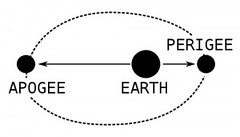
The Full Moon of March 19, 2011 will be a special type of full moon since it will coincide with the moon's perigee. When the moon is at perigee, it is at its closest approach to earth. This happens about every month but not every time there is a full moon. The illustration below shows the idea of perigee.

Not only will full moon and perigee coincide, but the Sun and Moon will be lined up with the earth's equator since it's almost the time of the vernal equinox (March 20th). The scientific term for this full moon at perigee is "perigee-syzygy" but astrologer Richard Nolle has coined the more vernacular term "supermoon."
Geophysicist, Fergus J. Wood, who was an expert on tidal phenomena, noted that since the new and full moons cause each month's highest tides, when the new or full moon coincides with the moon's perigee, tides are even higher. This is not too much of a problem, but when these larger tides are accompanied by strong on-shore winds, then damage can arise from coastal flooding. Although science can predict when these supermoons will occur years in advance, they cannot predict weather patterns that far in advance. This long-range weather prediction is the realm of astro-meteorology.
Fergus Wood seemed to be open to the fact that astronomical bodies might affect the weather. He said, "The seemingly above-average frequency of such concurrent events raises the question whether some interrelationship between respective astronomical and meteorological phenomena might exist which has not yet been established."
So let's look at what type of weather patterns are in store for the U.S. at this time and see if we can determine how this coming perigee-syzygy might affect those patterns.
On March 18th, we have an opposition between Mercury and Saturn--a definite storm breeder. On the 19th, we have a parallel between the Sun and Uranus. These two coincide with cold, dry air masses ushered in on northwest winds.
One possible interpretation of the different influences at work suggests that cold air will pour down through the Mississippi Valley and Great Lakes area and generate a storm system that is particularly intense from the Kentucky/Tennessee area down through the Florida Panhandle. The system then pushes eastward through the Mid-Atlantic. Since New England is under the influence of the Mercury-Saturn opposition the same storm system, or perhaps an independent one, affects that area. With the moon at perigee, these systems could be intensified.
Cyclone Yasi fulfills long-range prediction!
Overview of UK Winter 2012-13
The Winters of 2011-14
South Texas Wet Weather Feb 16-18, 2011
Significant West Coast Storm February 20-23, 2011
Midwest Winter Cold and Heating Oil
Tropical Storm Matthew Fulfills Long-range Forecast!
Hurricane Earl and T.D. 10E Fulfill Long-range Forecasts!
Tropical Storm Alex Fulfills Long-range Prediction!
Bonnie Fulfills Long-range Forecast!
Introduction to the Weather Alternative
How Long-Range Forecasts Are Made
God's Design
Astronomy [science] leads us to a unique event, a universe which was created out of nothing and delicately balanced to provide exactly the conditions required to support life. In the absence of an absurdly improbable accident, the observations of modern science seem to suggest an underlying, one might say, supernatural plan.--Nobel laureate Arno Penzias
It’s not just the universe as a whole that manifests design. Scientists find overwhelming design evidence no matter what volume size they investigate—the universe, our galaxy, planetary system, star, planets, cell, atom, and fundamental particles. On each of these size scales, evidence for extreme fine-tuning on the behalf of life and humanity persists.--Astrophysicist Hugh Ross
There is for me powerful evidence that there is something going on behind it all. It seems as though somebody has fine-tuned nature’s numbers to make the universe. The impression of design is overwhelming.--Paul Davies, British astrophysicist
8 comments:
Modesto Ca. has received nearly 2" of rain this week..It looks as though your projection for a big storm came in a little early...great call Ken.
I have a question...do you consider the declination of a particular planet in your projections?
Yes, Bob, declinations are important. So besides the regular aspects of conjunction, sextile, square, trine, and opposition, the parallel of declination is important. By this I mean that two planets have the same declination north of south of the equator.
To a lesser extent, the individual declination of a planet might affect a weather pattern but since they don't usually exceed 20 some-odd degrees north or south of the equator that planet's declination wouldn't affect weather patterns much further north or south.
Regarding the West Coast rain, I did mention that the pattern could start as early as Feb. 17th but I guess it might have started even earlier.
With this special full moon, my students have been bonkers these past two days!
Mountain State Teacher
Is this phase of moon in some way responsible for Japan earthquake and tsunami?
Swati,
I think the earthquake happened to far away in time from the Full Moon to connect the two. I may be wrong, however. I was thinking that it might be related to the approaching Jupiter-Saturn opposition.
Swati,
Now that I think about it, we're only about 8 days away from the SuperMoon. That doesn't seem too far of a stretch!
Post a Comment